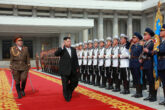November 01, 2018
Trumping Asia
In a cavernous Manila exhibition hall, flooded with light, U.S. President Donald Trump stood flanked by members of his national security team to deliver remarks to the press in November 2017. Joking that the White House press corps would need a day to recover from his first Asia trip – which covered five countries – the president observed, “It’s been an incredible 12 days. I’ve made a lot of friends at the highest levels.”
After intense public back-and-forth over Trump’s attendance at the 2017 East Asia Summit in the Philippines, he departed immediately following the leaders’ lunch, but before delivering official remarks. Officials cited a tight schedule, noting that the summit was running behind. Then-Secretary of State Rex Tillerson was left behind to speak in the president’s stead.
Nearly one year later, onlookers are still seeking clarity about the Trump administration’s Indo-Pacific strategy. Characterized by a newly declared strategic competition with China, “fair and reciprocal” trade deals, a free and open Indo-Pacific region, and increased emphasis on the Quad – a diplomatic grouping of Australia, India, Japan, and the United States – Trump’s approach is in some respects a predictable evolution of U.S. regional policy, while in other ways deeply disruptive. The administration’s ability to reconcile these competing forces into affirmative policy solutions will be the single largest factor that determines its relative success.
Read the full article in The Diplomat.
More from CNAS
-
Trump’s Audacious Success
This article was originally published in The Atlantic. Nicolás Maduro and his wife awoke yesterday in a safe house on a heavily fortified military base in the center of Caraca...
By Richard Fontaine
-
North Korea and Russia’s Deepening Axis
2025 was the year North Korea turned a corner, not just through provocations, but by actively repositioning itself in the global power game. Its military partnership with Russ...
By Dr. Go Myong-Hyun
-
CNAS Insights | Eight Things to Watch for in 2026
Buckle up for a pivotal geopolitical year. In 2026, the world will struggle to make sense of U.S. actions and intentions, and Washington will remain uncertain about its own pl...
By Richard Fontaine
-
North Korea in Motion: New Moves, Sharper Risks, and Shifting Regional Responses
As 2025 winds down, tensions on the Korean Peninsula are escalating once again.North Korea is sending thousands of workers to Russian drone factories, stepping up cyber theft ...
By Dr. Go Myong-Hyun




